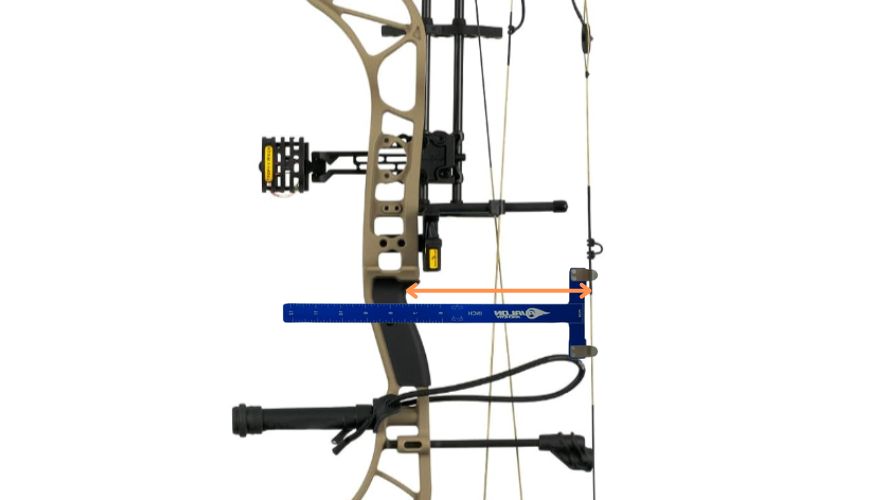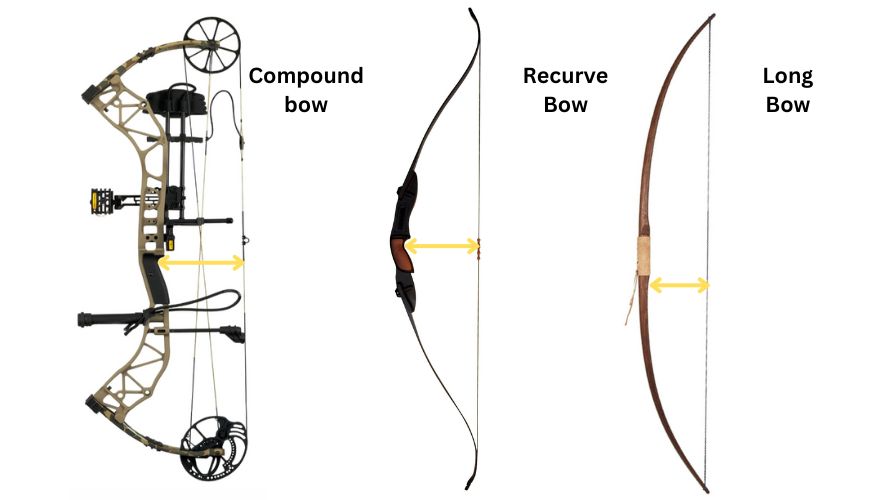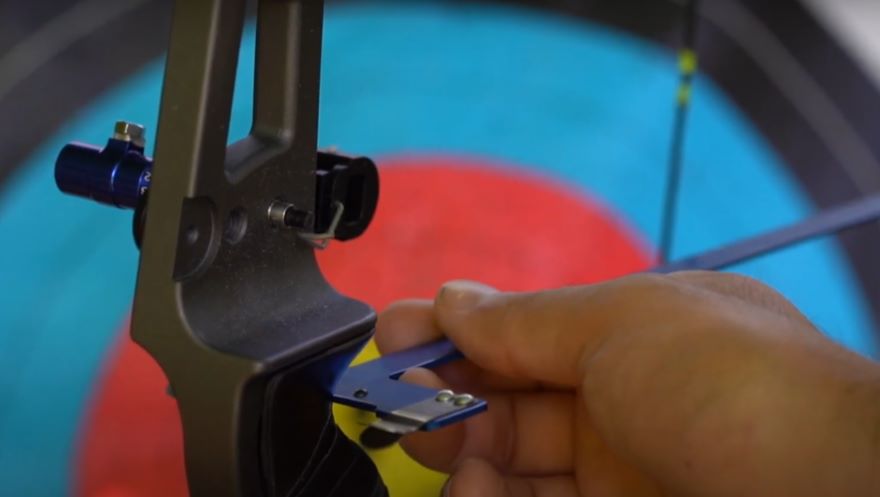You might be thinking what is brace height? well most of the archers don’t know what it is, but that is not a bad thing because you are always learning new things. Brace height is one of the important factors when selecting a bow. If that is so then it might also play an role in shooting? Yes exactly
In this article we will see what is brace height, how is it measured why is it important and how to adjust the brace height by twisting the bow string.
Definition of Brace Height
Brace height refers to the distance between the bowstring and the deepest part of the grip when the bow is at rest. It is usually measured in inches or centimeters. Understanding this measurement is crucial, as it directly affects the bow’s power stroke and subsequent arrow speed.
Here’s a general brace height table:
| Bow Type | Recommended Brace Height (inches) |
|---|---|
| Recurve Bows | 7.5 – 8.5 |
| Compound Bows | 6.5 – 7.5 |
| Longbows | 7.5 – 8.5 |
| Traditional Bows | 7.5 – 8.5 |
How Brace Height is Measured
To measure brace height accurately, use a measuring tape and position the bow horizontally. Gently press the tape against the deepest point of the grip and measure up to the point where the bowstring makes contact with the tape. You can also use a T square to measure the brace height.

The Role of Brace Height in a Bow
Brace height has some important roles in shooting experience, I am gonna break it down so you understand what it affects and how.
The Relationship Between Brace Height and the Power Stroke
Brace height significantly impacts the power stroke, which is the time it takes for the arrow to leave the bowstring during the shot. A shorter brace height leads to a longer power stroke, resulting in higher arrow speeds. Conversely, a longer brace height reduces the power stroke and arrow speed.
This works in a way like when you draw the bow string back with the arrow nocked, now a shorter brace height would give the arrow more time to be on the string after release because the string would go closer to the grip compared to a longer brace height.
The arrow will be released from the string late on a short brace height bow in comparison with the large meaning that the shorter brace height offers more time for string to transfer its energy, hence resulting in greater arrow speeds.
How Brace Height Affects Arrow Speed
A bow with a shorter brace height will shoot arrows at higher speeds due to the increased tension on the bowstring. This can be advantageous for certain archers, such as hunters requiring flatter trajectories and faster arrow delivery.
Now, when you draw the bowstring back, you’re creating tension in the string. With a shorter brace height, that tension in the string is more intense because the string doesn’t have as much room to stretch out.
On the other hand, when the brace height is longer, the string has more space to stretch out as you draw it back. This means the tension in the string is spread out over a greater distance, making it feel a bit more relaxed.
For every increase in an inch of brace height, the arrow speed decreases by 10 feet per second
The Impact of Brace Height on Bow Forgiveness
A longer brace height offers a more forgiving shooting experience. It provides a larger margin of error for imperfect releases and form, making it ideal for beginners or those seeking enhanced accuracy.
A longer brace height allows for a larger window of opportunity for the archer to release the bowstring cleanly. When the string stays in contact with the arrow for a more extended period, it mitigates the effect of minor inconsistencies in the release technique.
The Importance of Brace Height
The Influence of Brace Height on Shooting Accuracy
Achieving optimal brace height is essential for consistent and accurate shooting. An incorrectly adjusted brace height can lead to inconsistent arrow flight patterns, affecting precision. It can also cause your shot to be slow or not accurate.
The Role of Brace Height in Noise and Vibration Reduction
Proper brace height can help reduce noise and vibration during the shot, enhancing the archer’s stealth during hunting and improving shooting comfort. Short brace heights allow for more speeds and so transfers more energy to the arrow, this causes more noise and vibration.
A longer brace heights transfers less energy and the shot is much quieter. This factor can be decided by taking your shooting style into account.
How Brace Height Affects the Overall Performance of the Bow
An appropriate brace height enhances the bow’s overall performance, ensuring a harmonious interaction between the bow’s components, resulting in smoother shooting and better arrow grouping
Bows with a brace height of 6 inches or shorter or lower are considered short, while those approaching or exceeding 7 inches are considered long or higher.
Lower Brace Height: A lower brace height generally results in higher arrow speed, but it also increases noise and vibration upon release. Additionally, the arrow may be more sensitive to the shooter’s form, making it less forgiving.
Higher Brace Height: A higher brace height often reduces arrow speed but leads to a quieter shot and decreased sensitivity to the shooter’s form, enhancing forgiveness.
How to Adjust Brace Height
To adjust the brace height, you can twist or untwist the bowstring. You can also use a shorter or longer string depending on your goal. A professional bow technician can also assist in achieving the desired brace height.
The brace height on a compound bow should be selected when buying the bow because it is not as simple as a traditional bow, its very hard to get the string and twist it. Another option can be using a short length string but generally the brace heights shouldn’t be adjusted.
Key Concepts and Terms:
- Brace Height: The distance between the bowstring and the bow’s grip when the bow is unstrung.
- Positive Brace Height: When the bowstring is located above the grip at rest.
- Negative Brace Height: When the bowstring is located below the grip at rest.
- Nocking Point: The specific point on the bowstring where the arrow is attached.
Steps to Adjust Brace Height:
Step 1: Measure the Brace Height Using a bow square or ruler, measure the brace height by placing one end against the deepest part of the bow grip and aligning the other end with the bowstring. Take note of the measurement.
Step 2: Adjusting Brace Height
- To Increase Brace Height: If the brace height is lower than desired, twist the bowstring slightly to shorten it by pulling the limbs more. This will lift the bowstring, increasing the brace height. Usually two twists increase the string length by ¼ inch.
- To Decrease Brace Height: If the brace height is higher than desired, untwist the bowstring slightly to lengthen it. This will lower the bowstring, decreasing the brace height.
Step 3: Check the Nocking Point and Tiller After adjusting the brace height, check the nocking point position. The nocking point should be approximately 1/8 to 1/4 inch above square to achieve the best arrow flight. Additionally, ensure that the tiller remains consistent and balanced between the top and bottom limbs.
Step 4: Test and Fine-Tune Shoot a few arrows with the adjusted brace height and observe the arrow flight, accuracy, and consistency. Make small adjustments if necessary until the desired performance is achieved.
How Twisting the Bow String Works?
When you twist the bow string it shortens and pull the limbs of the bow together, this decreases the vertical distance of the bow limbs and increases the horizontal distance between the grip and the bow string. Similarly when you untwist the bow string, this increases the vertical distance bringing the string and body of the bow closer.
Recommended Brace Height Range:
Brace height depends on the type of bows and their how they are being use. I have listed some common brace height ranges.

Compound bow
| Brace Height Range (inches) | Suggested Use |
|---|---|
| 5.5 – 6.5 | Speed-oriented setup |
| 6.5 – 7.5 | All around performance |
| 7.5 – 8.5 | Forgiveness and smoothness |
| 8.5 and above | Traditional/long-draw setup |
Recurve Bow
| Bow Length (inches) | Brace Height Range (inches) | Suggested Use |
|---|---|---|
| 58 – 60 | 7.5 – 8.5 | All-around performance |
| 62 – 64 | 7.5 – 8.5 | Target archery |
| 66 – 68 | 7.5 – 8.5 | Olympic-style shooting |
| 70 | 7.5 – 9.0 | Traditional shooting |
Long Bow Ranges
| Longbow Length (inches) | Brace Height Range (inches) | Suggested Use |
|---|---|---|
| 60 – 64 | 7.5 – 8.5 | All-around performance |
| 65 – 69 | 7.5 – 8.5 | Traditional shooting |
| 70 and above | 8.0 – 9.0 | Traditional/Reenactment |
These ranges might work well for your bows but always prioritize the manufacturer’s recommended brace heights. The adjusting process is the same for all bows by twisting the bow string.
Factors to Consider When Selecting Brace Height
The Type of Bow Being Used:
Different types of bows, such as compound, recurve, and longbows, have their unique designs and mechanisms that influence their optimal brace height. Each bow type is engineered to perform optimally within a specific brace height range. Deviating significantly from the manufacturer’s recommendations can affect the bow’s performance, accuracy, and even safety. Always consult the manufacturer’s guidelines for your specific bow model to ensure you’re within the recommended range.
The Archer’s Shooting Style and Experience Level:
The brace height that works best for you can vary based on your shooting style and experience level. Novice archers might benefit from a more forgiving brace height that provides leeway for inconsistencies in form and release. More experienced archers who have honed their shooting technique might opt for a brace height that allows them to capitalize on their precision. Experimenting with different brace heights during practice sessions can help you discover what feels most comfortable and effective for your unique style.
The Intended Use of the Bow:
The purpose for which the bow will be used also influences the ideal brace height. For example:
Hunting: Hunters often value higher arrow speeds for a flatter trajectory and increased kinetic energy. A slightly shorter brace height can contribute to faster arrow speeds, making it a popular choice for hunting setups.
Target Shooting: Target archers typically prioritize accuracy and consistency. A slightly longer brace height can enhance forgiveness and control, factors crucial for achieving tight groupings in target shooting scenarios.
3D Archery: In 3D archery, where archers engage in simulated hunting scenarios with life-sized animal targets, a balance between speed and accuracy might be sought, depending on the competition’s format and the archer’s preference.
Traditional and Historical Reenactment: Longbows and traditional bows often have their own unique brace height preferences that align with historical practices and shooting techniques.
Bow Tuning and Arrow Setup:
The arrow setup, including arrow spine, weight, and fletching configuration, can also interact with the brace height. Changes in brace height can impact arrow flight, and thus, proper bow tuning is necessary to ensure consistent and accurate arrow grouping. You may need to adjust your arrow setup alongside brace height changes to achieve the desired results.
The Impact of Incorrect Brace Height
An incorrectly set brace height can lead to a host of issues, including decreased arrow speed, reduced accuracy, and increased hand shock or vibration.
Incorrect brace length can also harm you. If the brace height is too short then the bow string is closer to the grip. The arm gripping the bow has a potential risk of injury as it can be hit by the bow string. This can also affect the flight of arrow.
Risks Associated with Adjusting Brace Height:
There are risks associated with adjusting brace height before proper research and study, you must be very careful while doing anything with the bow string. Don’t try to adjust anything if you are unsure because it can damage your bow.
- String Damage: Adjusting the brace height too dramatically or incorrectly can cause excessive stress on the string fibers. This stress might lead to fraying, wear, or even breakage, which can be dangerous and render the bow unusable.
- Strand Separation: Flemish strings consist of multiple strands that are tightly braided together. Incorrectly adjusting the brace height can cause these strands to separate or fray, affecting the structural integrity of the string. This could potentially result in a string failure during shooting, leading to injury or damage to the bow.
- Performance and Accuracy: Even minor changes in brace height can impact arrow flight, accuracy, and overall performance. While it’s natural to want to experiment with different settings, excessively low or high brace heights can compromise the bow’s consistency and accuracy.
- Bow Limb Stress: Incorrect brace height adjustments can lead to uneven stress distribution on the bow limbs. This stress imbalance might cause the bow limbs to twist or warp over time, affecting both the shooting experience and the longevity of the bow.
Tips for Maintaining Optimal Brace Height
Regular Checks and Adjustments: Perform periodic checks on your brace height to ensure it remains consistent and optimal.
Importance of Consistent Brace Height: Maintaining a consistent brace height allows archers to develop muscle memory and improve shooting consistency over time.
Bow string care: Proper bowstring care can help preserve the integrity of the string and its performance.
Conclusion
I hope now the questions you had in the start of this guide have all been answered and are clear to you. Now you know how important is brace height and this basic information can help you grow a lot. Try out different brace heights and see which one works for you.
Make sure to consider the factors when choosing a brace height. My advice to beginners would be to use the brace height recommended by the manufacturer and if you really have to change then consider a forgiving brace height. Also do take notice of your bow tuning along with brace height.

Pingback: Restring a Compound bow - When Why and How? (Easy Steps)
Pingback: How to Choose The Right Compound Bow - Beginner's Guide
Pingback: How to Wax a Bow String Properly (6 Easy Steps)